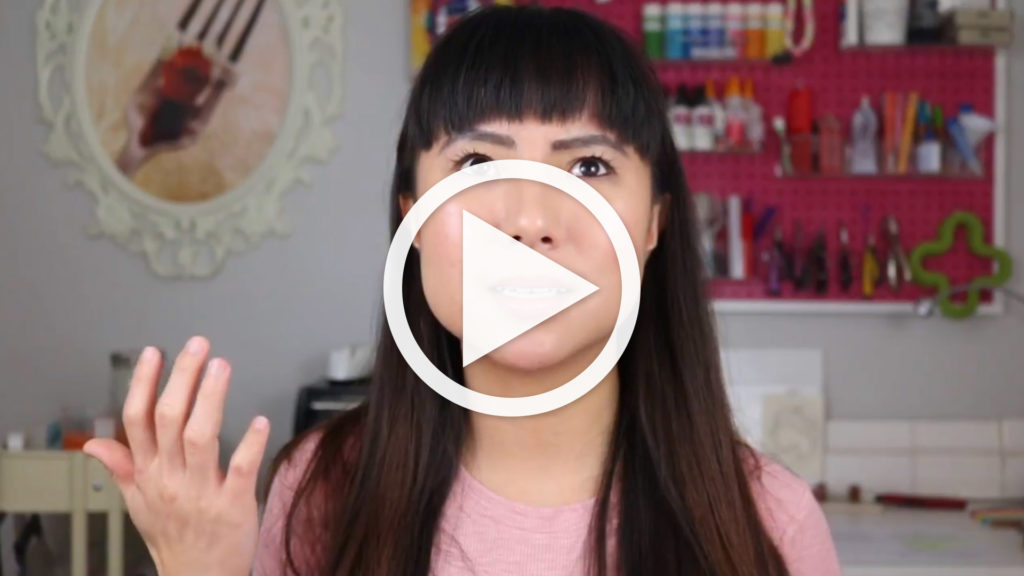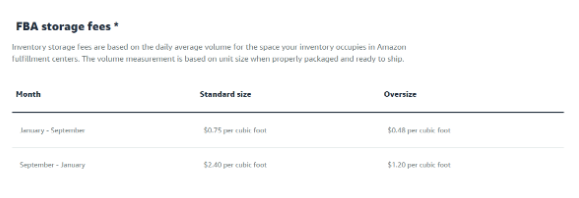I want to help you build a sustainable, profitable handmade business that makes you consistent income and sales. I only ever teach or recommend marketing, social media, pricing, production and branding tips that I’ve personally used successfully in my own 7-figure handmade businesses.
I'm Mei, from Los Angeles!
Read More
Popular Posts You'll Love
Looking for something?
Categories
starting a business
get more traffic
running a business
make more sales
branding
growing a business
mindset & productivity
podcasts
pricing & money
product photography
reviews
selling on etsy
selling on amazon
social media
selling wholesale
- Facebook0
- Twitter5
- Pinterest14
- 19shares
Are you struggling to wrap your head around the cost of selling your products on Amazon?
In this post, we’ll be taking a detailed look at Amazon’s fees whether you’re a seller on regular Amazon, Amazon Handmade or Fulfillment by Amazon. We’ll be breaking down the fees across each and giving examples so you can have a better idea of the cost you’re looking at to sell on Amazon.
Compared to Etsy, it’s a little bit more difficult to understand the different types of fees for selling on Amazon. However, once you get the hang of which fees apply and when, there are many advantages to selling on the world’s largest online marketplace.
If you’re not sure about the differences between regular Amazon, Amazon Handmade or Fulfillment by Amazon, I have a whole video talking about that. Today, we’re going to focus on the selling fees.
Selling Through Regular Amazon
If you choose to sell through the regular Amazon marketplace, there are 5 main things you need to consider:
1. Listing Fees
If you sign up with an Individual seller account, you have to pay 99 cents for every item that you list and sell.
If you use a Professional account, there are no listing fees but you’ll need to pay an upfront monthly fee of $39.99.
Therefore, if you sell 40 items or fewer per month, an individual account is for you. If you plan on selling over 40 items per month, a Professional account is a more economical option.
2. Item Price
Make sure your prices are formulated correctly. You don’t want to risk pricing too low and make very little profit (or even none at all) after you deduct your fees.
You also don’t want to be too high because this is a marketplace platform like Etsy, it’s easy for shoppers to do price comparison shopping. If you’re way more expensive than other similar products, it’s easy to lose out to the competition.
Do some research beforehand and check out how much similar products sell for in the market.
3. Shipping Costs
Although shipping costs are paid for by the customer and later credited to you, they’re still subject to the referral fee, just like Etsy.
If you have an individual seller account, the shipping charges are set by Amazon. They are calculated based on the category of item, its weight, and the type of shipping service selected by the buyer (for example, standard or expedited, domestic or international).
Amazon’s shipping charges may end up being less than it actually costs you to send the product to the customer. Make sure your product price accounts for this.
If you’re a Professional seller you can set your own shipping costs.
4. Gift Wrapping Charges
Professional sellers can choose to offer gift wrapping to customers. This gift wrapping fee you charge is also subject to Amazon’s referral fee.
5. Referral Fees
Depending on the category of products that your items fall under (for example jewelry, clothing, kitchen tools or toys & games) Amazon charges a referral fee of anywhere between 8% and 20% of the total sale price.
As previously mentioned this fee applies to any shipping or gift wrapping fees.
Calculating Your Earnings
To calculate how much you’ll earn from a sale, the formula is: Item price plus shipping cost (plus gift wrapping if applicable), minus the referral fee and a listing fee for individual sellers.
Let’s say you’re an individual seller who sold a keychain for $10 plus $4 shipping. The customer pays a total of $14. Amazon takes 15% as a referral fee, which is $2.10 and a $0.99 listing fee. The total fees for the sale are $3.09, so you get $10.91.

That makes the fee a 22% of your total sale price.
Bear in mind, you still need to package and ship the item to the customer and deduct your cost of goods, labor and any other business expenses to find out your true profits.
Now let’s take a look at someone who has a professional account and sells soft toys.
Let’s say that their toys are less than 2 pounds in weight and measure 6 inches each side. They list the item, with no fee, for $35 and their shipping cost is $5. The buyer pays a total of $40 for the toy. The referral fee for toys is 15%, which is $6 in this case. That leaves you with $34.

Don’t forget that professional accounts have to pay a monthly $39.99 fee, so the more products you sell every month, the more spread out that fee becomes and the less costly it is on you.
If you sold one soft toy every day with these exact same numbers, then your total fees to Amazon would be about 18% of your sales.
You can see how your profits increase when you can sell more and when you’re also at a higher price point where the potential listing fees play a more negligible role. You can definitely feel the 99 cents listing fee when your product price is only $10, right? But if you’re selling a $35 product, it’s less of an issue.
Selling through Amazon Handmade
So what about selling on Amazon Handmade?
Firstly, there are no listing fees or monthly fees.
The referral fee for each sale is a flat 15% per item, regardless of which category your product falls under.

This pricing is a lot easier to understand, right?
But if you’ve watched my video comparing regular Amazon to Amazon Handmade and Fulfillment by Amazon, you’ll see that Amazon Handmade actually performs the worst between the three selling programs.
So even though the pricing breakdown is more clear at first glance, don’t let that be the only deciding factor for choosing which program to sell in.

Selling through Fulfillment By Amazon
Finally, if you’d rather let Amazon take care of storing, packing and shipping your products, as well as doing customer service, they offer a service that does all this called Fulfillment by Amazon, or FBA for short.
Simply put, you send your products in bulk to an Amazon warehouse and once one of your FBA items sell, Amazon will handle all post-purchase logistics, from shipping to answering customer emails for that sale.
As you might expect, FBA comes with a number of additional fees. Firstly, there’s a fulfillment fee based on the size and weight of your products.
The current fee amounts look like this:

If we use the example of the soft toy from earlier, you can see that if it weighed a little under 2 pounds, you would need to pay a fulfillment fee of $4.90.
When you pack and ship products yourself, not only do you have to pay for shipping fees but you also have to buy mailing supplies and it takes you time to actually pack and ship the order. You don’t have to worry about any of that, which for some of you, makes the $4.90 sound really attractive.
However, there are still other FBA costs to think about. Each month you have to pay a storage fee based on how much space your inventory takes up in Amazon’s warehouse.

You’ll notice that the storage fees triple over October to December because of the increased shopping demand during the holiday season, and more shops competing to do FBA during this time.
Also, if your inventory has been sitting in the fulfillment center for more than a year, you’ll incur some storage fees.
You don’t have to worry about that if you’re planning your inventory strategically, and only sending in enough inventory to last a short period of time, like a few weeks to a month, before replenishing your inventory again.
Other potential extra charges to be aware of are removal fees. You’ll be charged if you want Amazon to remove your item and return it to you.
There are also returns processing fees for if a customer returns one of your items and unplanned service fees, for example, if you fail to label your items properly when you’re sending them to Amazon’s warehouse.
So let’s do an FBA example with the soft toy again. You send one box of two dozen soft toys to an Amazon warehouse. You pay for shipping to them just that one time. And let’s say again that each toy is boxed up neatly in a 6-inch square box.
The product price is the same as before, $35, but you don’t need to worry about shipping to the customer and shipping is free for Prime members anyway.
You’ll still pay a 15% referral fee on the product price, so that’s $5.25 and now you’ll need to pay Amazon the fulfillment fee of $4.90.
What about the storage fee? Since you sent Amazon two dozen soft toys, you would pay $2.25 every month to store them, but assuming you sell all two dozen toys every month, you can evenly divide that storage fee cost to just 9 cents per toy.
That’s really affordable!
So let’s add up all those costs. $5.25 in referral fees. Plus $4.90 in fulfillment fees. Plus 9 cents in storage fees. That adds up to $10.24 in fees. So you’ll get $24.76 when you sell your $35 soft toy.

In essence, those fees are about 30% of your sale price.
If you’re priced correctly and considering you don’t need to worry about packing your own orders and paying for shipping if you do FBA, that could still be very profitable, especially if you plan on selling a lot of products.
In my experience, the benefits that come with FBA are worth the investment. I saw a huge increase in sales once I got on FBA.
I think it’s worth it, but only if you’re priced correctly.
I hope this helps! If you have any questions about this, leave me a comment below, or even just to say if you found this helpful.

Leave a Comment
Liked this article? Share it!
Unlock a Profitable Handmade Business
in Just 12 Weeks Without Using Etsy
or Social Media
FREE WORKSHOP
This workshop is for anyone who makes and sells a handmade or physical product, including jewelry designers, artists, paper designers, bath & body product makers and more!
What You'll Discover
The #1 mistake people make with Etsy & social media that causes shops to FLOP
The secret to making it with your handmade shop so it's no longer just a hobby
How to make sales in your handmade shop with ease so you can finally get to 6-figures
TAKE ME THERE
Your email address will not be published. Required fields are marked *
Leave a Reply Cancel reply
About
Blog
A Sale A Day
Student Login
Free Class
Contact
Terms
Become A Student
Watch On YouTube
Student Reviews
See My Handmade Shop!




Thanks for the information about how to get your product listed on amazon you shared I appreciate your efforts and taking the time and sharing this content.